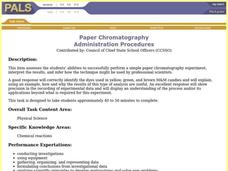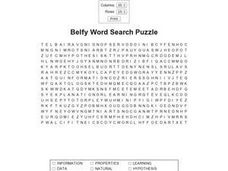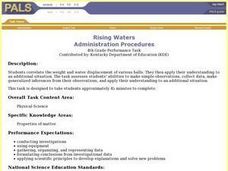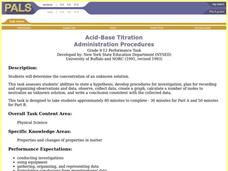Curated OER
Make a Snowflake
Students study the design of snowflakes. In this snow lesson, students discover the different shapes of a snowflake, and their similarities. Students study snowflakes outside, then create their own with popsicle sticks...
Curated OER
Colored Dots 1
Students observe that colored markers are a mixture of many different colors by performing a chromatography experiment. They make observations, record information, and make generalized inferences from their observations.
Curated OER
Density of a Sinker
Eighth graders determine the density of a sinker by first finding the mass and then the volume using a graduated cylinder. Students must write the procedure they use to find the volume of the sinker then apply their data to follow-up...
Curated OER
Threads
Students group observed data, filtering from all their observations the similarities between burring threads. In the second part they make a comparison of a chosen attribute between the two threads.
Curated OER
Identifying Elements
Students use diffraction glasses to find similarities and differences between observed spectrum of fluorescent light and an incandescent light They work in groups of 4-6 for the experiment/activity part of this exercise.
Curated OER
Using VNTR Analysis to Identify Guilt at a Crime Scene
Students collect DNA from cheek cells. They compare and contrast the processes of DNA replication and PCR. They discuss how this information can be used to determine guilt at crime scenes.
Curated OER
Paper Chromatography
Small groups of young scholars perform paper chromatography to separate food dyes into their component colors. Students perform the experiment and collect, organize, and represent their data to form an explanation of their outcomes....
Curated OER
Solution Concentration
Young scholars determine differences in concentrations. They have to state the problem they feel exists, consider possible solutions, and develop a plan to come up with for containers whose labels have fallen off. Students base this...
Curated OER
Packing Materials
Students observe the effects of water on four different packing materials to determine which ones are more soluble. They then decide which material would be a good packing material to use for the environment and which may be a bad...
Curated OER
Acid and Base Testing 2
Students design and conduct an experiment on unknown solutions after studying descriptions of indicators and the way in which they identify acids and bases. Students must gather, organize, and analyze data as well as make inferences...
Curated OER
Icebergs Ahead!
Young scholars examine icebergs and how they are suspended in water, why ice floats, the melting process of an iceberg, and the floating behavior of ice compared to that of a cork through a lab activity.
Curated OER
Modeling the Process of Mining Silicon Through a Single Displacement/Redox Reaction
Students study silicon and where it comes from. For this solar mining lesson students complete an Internet search of mining and a lab activity.
Curated OER
Oil Embargo!
Ninth graders generate and analyze data to determine which and how much of two polymers best absorb oils, formulate procedure to accurately determine how many times its own weight particular polymer can absorb, and develop understanding...
Curated OER
Oil Spill
Students use one of four absorbent products to separate as much of the oil and water mixture they are able to do. The purpose of this task is for students to collect and analyze data for the purpose of determining which absorbent is...
Curated OER
Belfy Word Search
In this language arts learning exercise, students study 20 words in a word bank, then locate them in a word search puzzle. The words appear to be related to chemistry but the meaning of the title is not known.
Curated OER
Laws of Motions
Seventh graders explore the Laws of Motion. They define friction and explain the concept of inertia. Students explain what happens when a force is exerted on an object that is in equilibrium. They state the second and third laws of motion.
Curated OER
Rising Waters
Fourth graders rank balls by size from smallest to largest and from lightest to heaviest and then by how much they made the water rise. They then discuss why certain balls make the water rise higher than do other balls.
Curated OER
Acid-Base Titration
High schoolers determine the concentration of an unknown solution. This task assesses students' abilities to state hypothesis, develop procedures for investigation, plan for recording and organizing observations and data, collect data,...
Curated OER
Forces and Energy Study Guide
Sixth graders use prior knowledge to create a tri-fold study guide using Microsoft Publisher (if available). They include real world examples that show balanced and unbalanced forces, kinetic and potential energy, and vocabulary. The...
Curated OER
Investigating and Using Biomass Gases
Students examine the definitions of biomas gasification and generate their own biomass gas. In this renewable energy instructional activity students collect gases and roast a marshmallow.
Curated OER
Root, Root, Root for the Nutrients
Young scholars observe the growth of a seed, predict what will happen when seeds are planted without soil, and conduct an experiment using a hydroponics system.
Curated OER
Technology of the Deep: Experiments with Buoyant Forces
Students conduct a series of experiments to study the effects of temperature and salinity on the buoyancy of an object in water. They devise ways to make floating and sinking objects neutrally buoyant.
Curated OER
Heating Crystals
Students examine the effects of heating on various crystals. They answer questions in the observation category which assess their ability to use a variety of senses to observe data in a certain way- a scientific way.
Curated OER
Locating Vent Fields Using CTD Data
Students describe the way hydrothermal vents work. Students work on locating vent regions through remote collection of data about water temperature and density. Comparing density and temperatures graphs, students search for indicators...

























